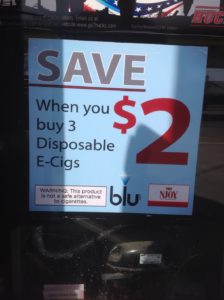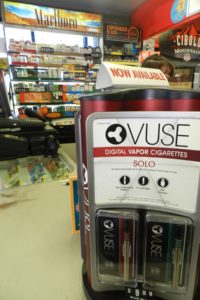Welcome to CounterTobacco.org’s “News and Research Roundup!” Each month we post a summary of the latest research, reports, and news stories on counteracting tobacco product sales and marketing at the point of sale (POS). Keeping up with what’s happening in the POS movement all across the country can help you choose policies and strategies that work best for your community. New research can help provide support for your work and evidence for the importance of the “War in the Store.” Have a story you don’t want us to miss? E-mail it to us!
New Research
Menthol and Other Flavored Tobacco Products
- Local sales restrictions significantly reduce the availability of menthol tobacco: Findings from four Minnesota cities, Tobacco Control
- St. Paul, Duluth, Minneapolis, and Falcon Heights, Minnesota were some of the first cities to restrict the sale of menthol tobacco products to adult-only stores. Using store audits of approximately 300 tobacco retailers, this study assessed changes in the availability
 and marketing of menthol products from before and after policy implementation in these four cities, as well as six comparison cities without a menthol policy. Researchers found that compliance with the menthol restriction was extremely high in the four cities, with Falcon Heights having a 100% compliance rate. In contrast, all tobacco retailers in the comparison cities, as well as 96% of the exempted tobacco stores in the four cities with the restriction, sold menthol tobacco products. Researchers noted that two retailers in Minneapolis created adult-only sections of their stores to continue to sell menthol products. Additionally, after the policy was implemented, retailers in Minneapolis, St. Paul, and Duluth all exhibited a significant reduction in menthol tobacco marketing on the interior of stores, while only retailers in Duluth had a decrease in menthol tobacco marketing on the exterior of stores. These findings highlight the impact a menthol restriction has on the availability and advertising of menthol tobacco products. Learn more about menthol products and restrictions on product availability.
and marketing of menthol products from before and after policy implementation in these four cities, as well as six comparison cities without a menthol policy. Researchers found that compliance with the menthol restriction was extremely high in the four cities, with Falcon Heights having a 100% compliance rate. In contrast, all tobacco retailers in the comparison cities, as well as 96% of the exempted tobacco stores in the four cities with the restriction, sold menthol tobacco products. Researchers noted that two retailers in Minneapolis created adult-only sections of their stores to continue to sell menthol products. Additionally, after the policy was implemented, retailers in Minneapolis, St. Paul, and Duluth all exhibited a significant reduction in menthol tobacco marketing on the interior of stores, while only retailers in Duluth had a decrease in menthol tobacco marketing on the exterior of stores. These findings highlight the impact a menthol restriction has on the availability and advertising of menthol tobacco products. Learn more about menthol products and restrictions on product availability.
- St. Paul, Duluth, Minneapolis, and Falcon Heights, Minnesota were some of the first cities to restrict the sale of menthol tobacco products to adult-only stores. Using store audits of approximately 300 tobacco retailers, this study assessed changes in the availability
- Assessment of menthol and nonmenthol cigarette consumption in the US, 2000 to 2018, JAMA Network Open
- This study measured consumption of menthol and nonmenthol cigarettes from 2000 to 2018. During this time period, cigarette consumption declined by 46%; however, this decline was significantly greater for nonmenthol cigarettes than menthol cigarettes, with 85% of the total decline being attributed to nonmenthol cigarettes. This rate was even more drastic since the passing of the 2009 Family Smoking Prevention and Tobacco Control Act, which exempted menthol from a ban on flavored cigarettes. Between 2009 and 2018, 91% of the decline in cigarette consumption could be attributed to nonmenthol cigarettes. These findings suggest that allowing menthol cigarettes to remain on the market may be hindering public health gains in reducing cigarette smoking. Learn more about menthol products and restrictions on product availability.
- “Because there’s just something about that menthol”: Exploring African American smokers’ perspectives on menthol smoking and local menthol sales restrictions, Nicotine & Tobacco Research
- In this study, 27 African American adults from the Minneapolis-St. Paul area, 96% of whom smoked Newport cigarettes, were interviewed in 2017 to explore smoking
 behaviors and perceptions of local menthol policies. The researchers found that the majority of participants perceived menthol cigarettes to be more harmful than non-menthol cigarettes and also recognized that African American/Black individuals and communities had been targeted with menthol products by the industry. Perceptions on local menthol policies varied with some individuals being ‘receptive’ and others viewing the policies as ‘unfair’; however, the researchers generally determined that there was an overall lack of understanding about the impact these policies had, especially on the African American/Black community. The researchers concluded that greater awareness, education, and support, especially for the most impacted populations like African American/Black communities, should surround menthol policies. Learn more about menthol products and the industry’s targeting of Black communities.
behaviors and perceptions of local menthol policies. The researchers found that the majority of participants perceived menthol cigarettes to be more harmful than non-menthol cigarettes and also recognized that African American/Black individuals and communities had been targeted with menthol products by the industry. Perceptions on local menthol policies varied with some individuals being ‘receptive’ and others viewing the policies as ‘unfair’; however, the researchers generally determined that there was an overall lack of understanding about the impact these policies had, especially on the African American/Black community. The researchers concluded that greater awareness, education, and support, especially for the most impacted populations like African American/Black communities, should surround menthol policies. Learn more about menthol products and the industry’s targeting of Black communities.
- In this study, 27 African American adults from the Minneapolis-St. Paul area, 96% of whom smoked Newport cigarettes, were interviewed in 2017 to explore smoking
POS Advertising, Marketing & Promotions
- Tobacco product promotions remain ubiquitous and are associated with use and susceptibility to use among adolescents, Nicotine & Tobacco Research
- Over 1,000 adolescents, ages 13 to 17, were surveyed in 2019 to assess ever and
 current smoking and vaping behaviors as well as exposure to tobacco product promotions. In this sample, 34% of participants had ever used a tobacco product and 20% currently used a tobacco product. Additionally, 91% of participants had seen a cigarette promotion in the past 30 days and 80% had seen an e-cigarette promotion in the past 30 days; the majority of these promotions were seen at the point of sale, on television or in movies, and on social media. Greater exposure to tobacco product promotions was significantly associated with ever and current cigarette and e-cigarette use, and, among never-users, was associated with susceptibility to e-cigarette use. Additional factors that were associated with increased use and susceptibility to use were family and peer use, as well as attitudes towards these products. Learn more about commercial tobacco marketing and advertising at the point of sale.
current smoking and vaping behaviors as well as exposure to tobacco product promotions. In this sample, 34% of participants had ever used a tobacco product and 20% currently used a tobacco product. Additionally, 91% of participants had seen a cigarette promotion in the past 30 days and 80% had seen an e-cigarette promotion in the past 30 days; the majority of these promotions were seen at the point of sale, on television or in movies, and on social media. Greater exposure to tobacco product promotions was significantly associated with ever and current cigarette and e-cigarette use, and, among never-users, was associated with susceptibility to e-cigarette use. Additional factors that were associated with increased use and susceptibility to use were family and peer use, as well as attitudes towards these products. Learn more about commercial tobacco marketing and advertising at the point of sale.
- Over 1,000 adolescents, ages 13 to 17, were surveyed in 2019 to assess ever and
Disparities
- Widening disparities in cigarette smoking by race/ethnicity across education level in the United States, Preventive Medicine
- This study, using data from nine Tobacco Use Supplements to the Current Population Surveys between 1992 and 2018, found disparities in tobacco use and inequities in tobacco control across racial and ethnic lines as well as educational level. Across all races and ethnicities, lower educational attainment was correlated with increased ever and current smoking prevalence. Within each racial and ethnic category, education-level disparities widened over time, with the gap in current and ever use between those with the lowest level of educational attainment (less than high school) and highest level of attainment (college graduate) being largest for African Americans and non-Hispanic Whites, compared to Hispanics. Over this time period, college graduates of all racial/ethnic groups had the highest quit rates, with these rates rising over time for Hispanics and non-Hispanic Whites, but not for African Americans. The researchers also documented more progress in tobacco control for non-Hispanic Whites. Learn more about disparities.
- Evaluating how licensing-law strategies will impact disparities in tobacco retailer density: A simulation in Ohio, Tobacco Control
- This study simulated the potential impact of four licensing-law strategies (1- capping the number of retailers, 2- declustering retailers, 3- school-based regulations like restricting
 tobacco sales near schools, and 4- pharmacy bans) using over 11,000 retailers in Ohio. The researchers found that the most impactful licensing strategy varied and depended on the type of community. For instance, school-based strategies were most equitable for urban, lower-income, and predominately Black and African-American neighborhoods, whereas capping-based strategies were most equitable for rural neighborhoods. Pharmacy bans demonstrated inequitable impacts. The researchers concluded that, since policies may potentially reduce inequities or heighten disparities, policymakers should take into consideration a community’s unique characteristics and context when determining licensing strategies. As evidenced by their simulation, with the appropriate strategy, high risk communities have the capability to reduce their tobacco retailers by over 20%. Learn more about licensing and other policy solutions.
tobacco sales near schools, and 4- pharmacy bans) using over 11,000 retailers in Ohio. The researchers found that the most impactful licensing strategy varied and depended on the type of community. For instance, school-based strategies were most equitable for urban, lower-income, and predominately Black and African-American neighborhoods, whereas capping-based strategies were most equitable for rural neighborhoods. Pharmacy bans demonstrated inequitable impacts. The researchers concluded that, since policies may potentially reduce inequities or heighten disparities, policymakers should take into consideration a community’s unique characteristics and context when determining licensing strategies. As evidenced by their simulation, with the appropriate strategy, high risk communities have the capability to reduce their tobacco retailers by over 20%. Learn more about licensing and other policy solutions.
- This study simulated the potential impact of four licensing-law strategies (1- capping the number of retailers, 2- declustering retailers, 3- school-based regulations like restricting
E-Cigarettes/Vape Shops
- Is vaping better than smoking cigarettes?, European Heart Journal
- This article provides answers to frequently asked questions about e-cigarettes, like whether vaping is as dangerous as smoking cigarettes. The authors ultimately conclude that, while switching from cigarettes to e-cigarettes reduces risk of harm and may improve attempts at smoking cessation, evidence about the population-level consequences of e-cigarettes remains severely limited. Given the incomplete understanding of the long-term health and population-level effects of e-cigarettes and the potential for these products to addict a new and younger generation, the authors suggest that strict regulations of these products be put in place. Learn more about e-cigarettes and policy solutions.
- Vape shop owners/managers’ opinions about FDA regulation of e-cigarettes, Nicotine & Tobacco Research
- During the summer of 2018, the Food and Drug Administration [FDA] began implementing regulations such as minimum age verification, bans on sampling products, and requirements of health warnings. At this time, researchers interviewed 45
 vape shop owners/managers from six cities (Atlanta, Boston, Minneapolis, Oklahoma City, San Diego, and Seattle) about their businesses and their perceptions about the FDA regulations. On the whole, vape shop owners/managers discussed starting their businesses with positive intentions for their customers in mind and training their staff to fully adhere to any regulations. Despite this, many owner/managers indicated significant concerns related to the impact of the FDA regulations. Concerns included, but were not limited to, financial repercussions of the regulations (especially for smaller businesses), challenges understanding and interpreting the regulations, a lack of evidence supporting the regulations, and negative impacts on customer experiences. These concerns should be considered when educating retailers on new regulations and assessing compliance. Learn more about e-cigarettes at the point of sale.
vape shop owners/managers from six cities (Atlanta, Boston, Minneapolis, Oklahoma City, San Diego, and Seattle) about their businesses and their perceptions about the FDA regulations. On the whole, vape shop owners/managers discussed starting their businesses with positive intentions for their customers in mind and training their staff to fully adhere to any regulations. Despite this, many owner/managers indicated significant concerns related to the impact of the FDA regulations. Concerns included, but were not limited to, financial repercussions of the regulations (especially for smaller businesses), challenges understanding and interpreting the regulations, a lack of evidence supporting the regulations, and negative impacts on customer experiences. These concerns should be considered when educating retailers on new regulations and assessing compliance. Learn more about e-cigarettes at the point of sale.
- During the summer of 2018, the Food and Drug Administration [FDA] began implementing regulations such as minimum age verification, bans on sampling products, and requirements of health warnings. At this time, researchers interviewed 45
- The road to vaping: E-cigarette susceptibility and curiosity among U.S. adolescents susceptible and nonsusceptible to cigarette smoking, Health Education & Behavior
- Using data from the 2018 U.S. National Youth Tobacco Survey, this study of nearly 13,500 adolescent never cigarette or e-cigarette users attempted to identify factors associated with e-cigarette susceptibility and curiosity. Among adolescents susceptible to cigarette use, non-Hispanic Black participants were significantly less likely to be susceptible to or curious about e-cigarettes, compared to non-Hispanic Whites. Among adolescents not susceptible to cigarette use, Hispanic participants were significantly more likely to be susceptible to and curious about e-cigarettes. Among all adolescents in the study (both those susceptible to and not susceptible to cigarette use), participants who identified as female, were exposed to e-cigarette emissions in public places, were exposed to e-cigarette ads at the point of sale, and had low perceived harm and addictiveness of e-cigarettes compared to cigarettes had greater odds of susceptibility to and curiosity about e-cigarettes. Learn more about e-cigarettes.
- E-cigarette availability, price promotions and marketing at the point-of-sale in the contiguous United States (2014-2015): National estimates and multilevel correlates, Preventative Medicine Reports
- Using a national sample of roughly 2,000 tobacco retailers each year, this study analyzed changes in e-cigarettes at the point of sale between 2014 and 2015. In 2014, 72.0% of the retailers in the sample sold e-cigarettes, with this number increasing to 79.2% by the following year; the largest increase in e-cigarette availability during this time frame was at dollar stores and supermarkets. Price promotions at these retailers
 also increased from 11.9% of retailers offering price promotions in 2014 to 20.2% in 2015. A greater proportion of new e-cigarette retailers was found in neighborhoods with predominately Black residents. Additionally, e-cigarette price promotions were most prevalent in predominantly Hispanic neighborhoods and exterior e-cigarette advertisements were most prevalent in predominately Black neighborhoods. In states with a higher smoking prevalence, more stores sold, promoted, and advertised e-cigarettes. While the data is slightly outdated from 2014 and 2015 given the rapidly changing e-cigarette product and regulatory landscape, this study offers great insight into various point-of-sale strategies being used, and ramped up, in the retail environment. Learn more about e-cigarettes at the point of sale.
also increased from 11.9% of retailers offering price promotions in 2014 to 20.2% in 2015. A greater proportion of new e-cigarette retailers was found in neighborhoods with predominately Black residents. Additionally, e-cigarette price promotions were most prevalent in predominantly Hispanic neighborhoods and exterior e-cigarette advertisements were most prevalent in predominately Black neighborhoods. In states with a higher smoking prevalence, more stores sold, promoted, and advertised e-cigarettes. While the data is slightly outdated from 2014 and 2015 given the rapidly changing e-cigarette product and regulatory landscape, this study offers great insight into various point-of-sale strategies being used, and ramped up, in the retail environment. Learn more about e-cigarettes at the point of sale.
- Using a national sample of roughly 2,000 tobacco retailers each year, this study analyzed changes in e-cigarettes at the point of sale between 2014 and 2015. In 2014, 72.0% of the retailers in the sample sold e-cigarettes, with this number increasing to 79.2% by the following year; the largest increase in e-cigarette availability during this time frame was at dollar stores and supermarkets. Price promotions at these retailers
- Intention to quit vaping among United States adolescents, JAMA Pediatrics
- Using data from Wave 4 of the PATH survey, researchers sampled 500 youth, aged 12 to 17, who had used e-cigarettes in the past 30 days to examine quitting intentions and past e-cigarette quit attempts. Roughly 45% of the sample reported seriously thinking about quitting, with 50% reporting wanting to do so within the next month. 25% of the sample had reported a quit attempt within the past year. Intention to quit and quit attempts were similar across a variety of subgroups including sex, race, and household income. Learn more about e-cigarettes.
- News story: Nearly half of U.S. teens who vape want to quit, U.S. News & World Report
- The effects of traditional cigarette and e-cigarette tax rates on adult tobacco product use, Journal of Risk and Uncertainty
- Using data from the Behavioral Risk Factor Surveillance System and National Health
 Interview Study from 2011 to 2018, this study looked at the effects of increased cigarette and e-cigarette taxes on rates of adult use. The researchers found that, when taxes were raised on cigarettes, cigarette use declined but e-cigarette use increased; a similar pattern occurred when e-cigarette taxes were raised, suggesting these products are economic substitutes. The researchers also concluded that a national e-cigarette tax of $1.65 per milliliter of vaping liquid would increase the percentage of adult daily cigarette smokers by 1%, an equivalent of 2.5 million new adult daily smokers. Learn more about increasing tobacco prices.
Interview Study from 2011 to 2018, this study looked at the effects of increased cigarette and e-cigarette taxes on rates of adult use. The researchers found that, when taxes were raised on cigarettes, cigarette use declined but e-cigarette use increased; a similar pattern occurred when e-cigarette taxes were raised, suggesting these products are economic substitutes. The researchers also concluded that a national e-cigarette tax of $1.65 per milliliter of vaping liquid would increase the percentage of adult daily cigarette smokers by 1%, an equivalent of 2.5 million new adult daily smokers. Learn more about increasing tobacco prices.
- Using data from the Behavioral Risk Factor Surveillance System and National Health
Health Warnings and Labeling
- Smokers’ exposure to perceived modified risk claims for e-cigarettes, snus and smokeless tobacco in the United States, Nicotine & Tobacco Research
- Using data from individuals who self-reported smoking in Wave 3 of the PATH survey, this study found that 29.1% of participants remembered seeing “less harmful” product claims in the past 12 months on e-cigarettes, 5.1% recalled seeing such claims on snus in the past 12 months, and 5.6% recalled seeing such claims on other smokeless tobacco products in the same time frame. Recollection of these claims were highest among participants who perceived the product to be safer than cigarettes, currently used the product, and had more exposure to point-of-sale advertising. Roughly 25% of the surveyed individuals who smoked cigarettes and who recalled noticing these “less harmful” claims reported they would try one of these products in the future. Learn more about point-of-sale advertising and health warnings.
Other
- The importance of including youth research in premarket tobacco product and modified risk tobacco product applications to the Food and Drug Administration, Journal of Adolescent Health
- This commentary, co-written by a handful of experts in the field of tobacco control, calls on the Food and Drug Administration to require manufacturers to submit research on the impact of their product and its marketing and labeling on youth as part of any premarket or modified risk application. Learn more about the industry’s targeting of youth and ways to engage youth in the fight against Big Tobacco.
- News story: FDA should require research on impact of e-cigarettes and other tobacco products on youth before authorizing marketing of tobacco products and claims of modified risk, Campaign for Tobacco-Free Kids
- Co-optation of harm reduction by Big Tobacco, Tobacco Control
- This editorial takes a critical look at how Big Tobacco has co-opted the term ‘harm reduction’, which typically defines a community-based movement rooted in social justice and activism, and presents the idea that it is a bit of an ethical oxymoron to promote harm reduction while also marketing and selling these products to an expansive audience, not just targeted groups like current smokers, to gain profit and growth. Learn more about the industry’s manipulative tactics at the point of sale.
- Popularity of Natural American Spirit cigarettes is greater in U.S. cities with lower smoking prevalence, Addictive Behaviors
- Using data from 30 cities from September 2018 to September 2019, researchers
 examined associations with sales volumes of Natural American Spirit (NAS) cigarettes. They found that sales volume of NAS cigarettes was greater in cities that had lower smoking prevalence among adults. This finding may evidence that NAS cigarettes, which are often perceived as a ‘safer’ cigarette, may be particularly appealing in communities where non-smoking norms are stronger. The researchers also found that sales volumes of Marlboro and Pall Mall cigarettes, unlike sales volumes of NAS cigarettes, were higher in cities with lower cigarette excise taxes. Learn more about policy solutions at the point of sale.
examined associations with sales volumes of Natural American Spirit (NAS) cigarettes. They found that sales volume of NAS cigarettes was greater in cities that had lower smoking prevalence among adults. This finding may evidence that NAS cigarettes, which are often perceived as a ‘safer’ cigarette, may be particularly appealing in communities where non-smoking norms are stronger. The researchers also found that sales volumes of Marlboro and Pall Mall cigarettes, unlike sales volumes of NAS cigarettes, were higher in cities with lower cigarette excise taxes. Learn more about policy solutions at the point of sale.
- Using data from 30 cities from September 2018 to September 2019, researchers
COVID-19
- Tobacco quit intentions and behaviors among cigar smokers in the United States in response to COVID-19, International Journal of Environmental Research and Public Health
- In this online study from April to May of 2020, researchers surveyed 777 individuals who had smoked cigars in the past 30 days to assess their smoking behaviors, perceived risk of COVID-19, and quit intentions. 76% of the sample believed that, compared to non-smokers, they had a higher risk of complications from COVID-19. Despite this, 41% of the sample reported increasing tobacco use since the pandemic started, while only 18% reported decreasing use. 71% of participants reported intentions to quit in the next six months due to COVID-19 and 47% reported at least one quit attempt since the beginning of the pandemic. Black participants, those who reported contacting a quit line, and those with stronger risk perceptions of COVID-19 more often reported intentions to quit tobacco use due to COVID-19 and also had higher odds of a quit attempt since COVID-19 began.
- News story: Though concerned about COVID-19, cigar smokers are smoking more, survey finds, EurekAlert!
- Association between youth smoking, electronic cigarette use, and Coronavirus disease 2019, Journal of Adolescent Health
- Researchers conducted a national online survey of 4,351 young adults, ages 13 to 24,
 in May of 2020 to assess associations between youth cigarette and e-cigarette use and COVID-19. In this sample, COVID-19 diagnosis was 5 times more likely among ever users of e-cigarettes only, 7 times more likely among dual ever users of e-cigarettes and cigarettes, and 6.8 times more likely among past 30-day dual users of e-cigarettes and cigarettes. Symptoms were also 4.7 times more likely among past 30-day dual users of these products.
in May of 2020 to assess associations between youth cigarette and e-cigarette use and COVID-19. In this sample, COVID-19 diagnosis was 5 times more likely among ever users of e-cigarettes only, 7 times more likely among dual ever users of e-cigarettes and cigarettes, and 6.8 times more likely among past 30-day dual users of e-cigarettes and cigarettes. Symptoms were also 4.7 times more likely among past 30-day dual users of these products. - News story: Young vapers up to 7 times more likely to get COVID-19 than non-eicg users, says new Stanford study, NBC News
- Researchers conducted a national online survey of 4,351 young adults, ages 13 to 24,
- Underlying respiratory diseases, specifically COPD, and smoking are associated with severe COVID-19 outcomes: A systematic review and meta-analysis, Respiratory Medicine
- Researchers conducted an analysis of 22 studies on prevalence of respiratory disease and/or smoking in conjunction with severity of COVID-19 in patients. Through pooled analysis, researchers found that current smokers had 1.98 times the odds and former smokers had 3.46 times the odds of severe COVID-19 outcomes (defined as being admitted to the ICU, worsening condition after hospitalization, identification of ‘severe outcomes’ according to national guidelines, or death), compared to what was classified as non-severe COVID-19 outcomes.
- News story: COPD and smoking may be associated with more severe outcomes in COVID-19, Pulmonology Advisor
EVALI
- Pathological findings in suspected cases of e-cigarette, or vaping, produce use-associated lung injury (EVALI): A case series, The Lancet Respiratory Medicine
- News story: Autopsies, biopsies link lung injury to e-cigarette use, HCP Live
- The EVALI outbreak and vaping in the COVID-19 era, The Lancet Respiratory Medicine
Reports
- Tobacco nation in the age of COVID-19, Truth Initiative
- This report looks at tobacco’s role in the COVID-19 pandemic and the policies that can be implemented to reduce inequities and harms caused by tobacco use.
- Retail tobacco density & access, ASPiRE
- This report provides snapshots of the tobacco retail environment in 30 major US cities,
 including the concentration of tobacco retailers in low-income areas, the density of retailers, and the proximity of tobacco retailers to schools and other tobacco retailers. Find the executive summary here, a press release here, a news story by Washington University in St. Louis here and state-specific data here.
including the concentration of tobacco retailers in low-income areas, the density of retailers, and the proximity of tobacco retailers to schools and other tobacco retailers. Find the executive summary here, a press release here, a news story by Washington University in St. Louis here and state-specific data here.
- This report provides snapshots of the tobacco retail environment in 30 major US cities,
- Tobacco 21: Policy evaluation for comprehensive tobacco control programs, Centers for Disease Control and Prevention
- This guide provides tools to help state, local, territorial, and tribal health departments plan and initiate evaluation of the federal legislation that raised the minimum legal sales age of tobacco products to 21. The guide also supports the evaluation of any state, local, territorial, or tribal Tobacco 21 policies.
- Patterns of tobacco product use in the United States: Transitions across three waves of the PATH Study (2013-2016), Tobacco Control
- The journal Tobacco Control recently made open access this supplement, which includes multiple longitudinal studies that use the PATH Study. The articles examine changes in tobacco product use in youth, young adults, and adults from 2013 to 2016.
- Tobacco product use among high school students – Youth Risk Behavior Survey, United States, 2019, Morbidity and Mortality Weekly Report
- This CDC report provides updated statistics on youth use of tobacco products from the 2019 Youth Risk Behavior Survey.
- News story: Rise in youth use of e-cigarettes is a major concern, Medical Xpress
Industry News

- Altria expands sales of heated-cigarette as revenue slides, AP News
- Juul submits application to FDA to keep selling e-cigarettes, Reuters
- BAT awaits FDA approval to begin COVID-19 vaccine trial by Reynolds subsidiary, Winston-Salem Journal
- Juul labs sues over illegal U.S. sales, CSP Daily News
- Juul files new round of suits against ‘fake, copied’ vape rivals, Bloomberg
- Premium cigars gain exemption from California’s proposed flavored tobacco ban, HalfWheel
- Court delays FDA product approval requirements for premium cigars indefinitely, HalfWheel
- Big tobacco mounts ad blintz against Calif flavor ban (SB 793) making its usual failing arguments, UCSF Center for Tobacco Control Research and Education
POS Policy in the Media
E-Cigarettes
- Lawmakers urge the FDA to temporarily clear e-cigarettes from market amid Covid pandemic. Here’s why, CNN Health
- AG Ferguson sues California internet vaping retailer for illegal sales, Washington State Office
 of the Attorney General
of the Attorney General - Reynolds American gains on Juul by marketing vaping as cool again, The Wall Street Journal
- Retailers and e-cigarette manufacturer sue to block Philadelphia’s new e-cig rule, Lexis Legal News
Tobacco 21
- Georgia’s Governor signs bill raising tobacco purchasing age to 21-years-old, HalfWheel
- NH tobacco age raised to 21 after push by Sen. Watters, Dover youth, Fosters.com
- Nebraska raises legal smoking age to 21, KSCJ.com
Menthol and Other Flavored Tobacco Products
- [CA] LA vape flavor ban survives tobacco industry challenge, Law360
- Montana drops proposed flavored vapes ban, The Fairfield Sun Times
- [OR] Governor’s vaping panel calls for higher taxes, flavor ban to attack youth use, Portland Business Journal
- California on track to ban flavored tobacco products, CBS SF Bay Area
Tobacco Retailer Licenses
- [CA] Oceanside to require tobacco retailer license, The San Diego Union-Tribune
Other
- [MA] Adams Board of Health sets permit cap on tobacco sales, iBerkshires.com
- Web-based tool calculates policy implications of tobacco control, Yale School of Public Health
Find more stories in last month’s News and Research Roundup.
Know of a story that we missed? Email us, and we’ll be sure to include it in next month’s roundup!


